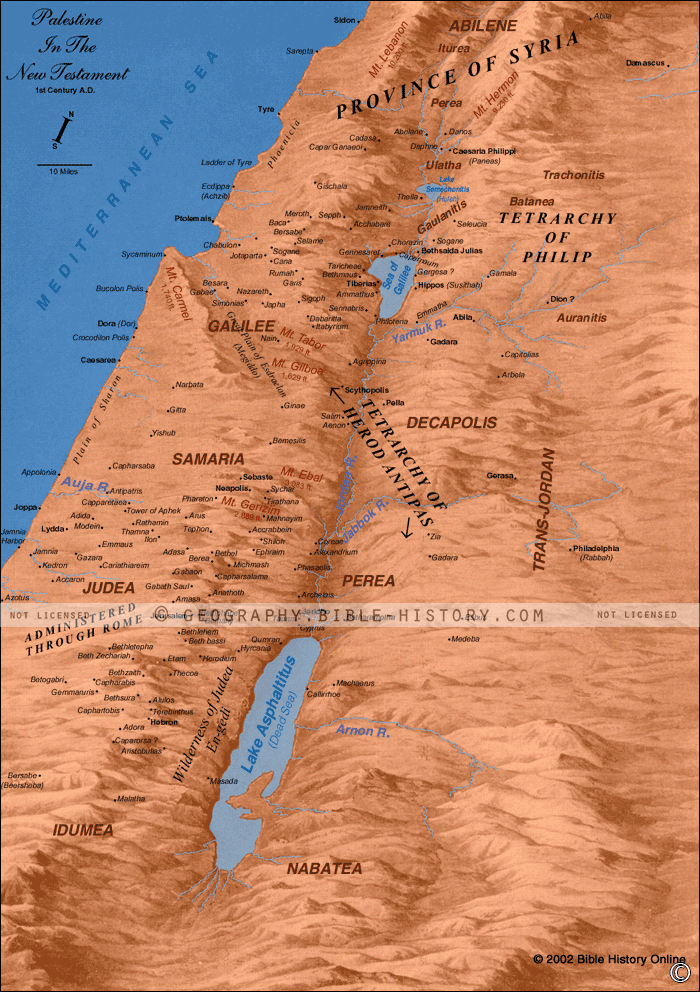
The map of the Cities of the New Testament 4 continues the immersive journey through historically significant urban centers that played pivotal roles in the New Testament narrative. These cities were not only geographical locations but also the vibrant settings where early Christianity spread and thrived. Here is a description of this compelling historical map:
Extended Geographical Scope:
This map further extends its geographical scope, encompassing additional cities and regions mentioned in the New Testament. It provides an even broader view of urban centers across the eastern Mediterranean, including areas in modern-day Turkey, Greece, and beyond.
Prominent Cities and Landmarks:
The map prominently features additional cities and landmarks closely associated with the events, missions, and Christian communities of the New Testament. It includes places like Ephesus, Miletus, Troas, Thessalonica, and Malta, among others.
Religious and Historical Significance:
This map emphasizes the religious and historical significance of these cities in the Christian tradition. It highlights the places where pivotal events, missionary activities, and the composition of New Testament writings took place.
Historical Context:
The map provides valuable historical context for these New Testament cities, shedding light on their political, social, and cultural environments during the Roman Empire era. It explores the diverse populations, religious diversity, and social dynamics that characterized these urban settings.
Missionary Routes and Journeys:
It outlines the missionary routes and journeys of key figures in early Christianity, such as the apostle Paul, as they traveled to these cities to spread the Gospel and establish Christian communities.
Cultural Insights:
Exploring the map allows viewers to gain insights into the culture, society, and daily life of the people living in these New Testament cities. It provides a window into the customs, traditions, and challenges faced by the early Christian communities in these diverse locales.
Religious Communities and Sites:
The map may also indicate the locations of early Christian congregations, places of worship, and significant sites where biblical events, miracles, and teachings unfolded.
Archaeological Discoveries:
Incorporating markers or references to archaeological discoveries and excavations in these cities can provide tangible evidence of the historical accuracy of New Testament accounts and the enduring legacy of early Christianity.
The map of the Cities of the New Testament 4 expands the exploration of the urban tapestry of the New Testament narrative. It invites viewers to immerse themselves even deeper into the geography, history, and cultural context of these iconic cities, further enriching their understanding of the events, teachings, and early Christian communities that shaped the New Testament story.
Blank Topo Map of The World
Abraham’s Journey
The Captivity of Judah (586-516 B.C.)
The Fall of Judah 586 B.C.
The Northern Kingdom of Israel
The Southern Kingdom of Judah
The Divided Kingdom
The Fertile Crescent
Ur of the Chaldees
Shechem in Old Testament Times
Prophets, Kings, and Nations
Jesus Last Passover
New Testament Israel
New Testament Places
Old Testament Israel
Provinces of the Roman Empire
Israel during David’s Kingdom
David’s Kingdom
Cities of the New Testament 4
Cities of the New Testament 3
Cities of the New Testament 2
Mediterranean Sea
Cities of the New Testament
First Century Jerusalem
Empire of David and Solomon
David’s Kingdom
Israel Under Rehoboam
Ophir and Tarshish
The Period of the Kings
Ramoth Gilead
Samaria
Solomon’s Temple
Zarephath and MT Carmel
Jabesh Gilead and Tribes
Judah in the Time of David
Kingdom of Saul
Kirjath Jearim
Michmash
Mount Gilboa in the Time of David
Nob Davids Flight
Shiloh
Israel and Judah
Assyrian Empire Under Esarhaddon
Assyrian Empire Under Sennacherib
Captivity of 10 Tribes
Events in 2 Kings
The Khabur River
Israel and Syria
Captives From Judah
Kingdom of Jeroboam
Mesha’s Kingdom
Pharaoh Necho Battles King Josiah at Megiddo
Babylonian, Mede and Persian Empires
Samaria and Nearby Territories
Syria at its Height
Hebron
Mahanaim
1949 Map of Israel With Boundaries
First & Second Journeys of Paul
Journeys of the Apostles
Paul’s Third Missionary Journey
Saul’s Journey to Damascus and Arabia
Paul’s Final Visits
Paul’s 1st Missionary Journey
Paul’s 2nd Missionary Journey
Paul’s 3rd Missionary Journey
Paul’s Voyage to Rome
Phillip Journeys to Samaria and Gaza
Judah at the Time of Amos
Empire of Alexander the Great
Israel Under the Maccabees
Galilee During Maccabees
Idumea Intertestamental Period
Kingdom of the Ptolemies
Kingdom of the Seleucids
Ptolemaic Egypt Seleucid Asia
The Roman World
Kingdom of Ptolemies and Seleucids
The World During the 6TH Century BC
Mount Horeb
The Red Sea
The Exodus
Ezra’s Journey to Restore Jerusalem
Israel and Judah During Hosea’s Time
The Ancient World
Canaan During the Time of Abraham
The City of Shechem
Supposed Location of the Garden of Eden
The Land of Israel in Genesis
The Jordan River
The Kingdom of Nimrod
Mount Ararat and Mesopotamia
The Descendants
Sodom and Gomorrah
The Kingdom of Egypt
The Hamites
The Kingdom of the Hittites
Ur of the Chaldees
Judah at the Time of Haggai
Jesus Passes Through Samaria
